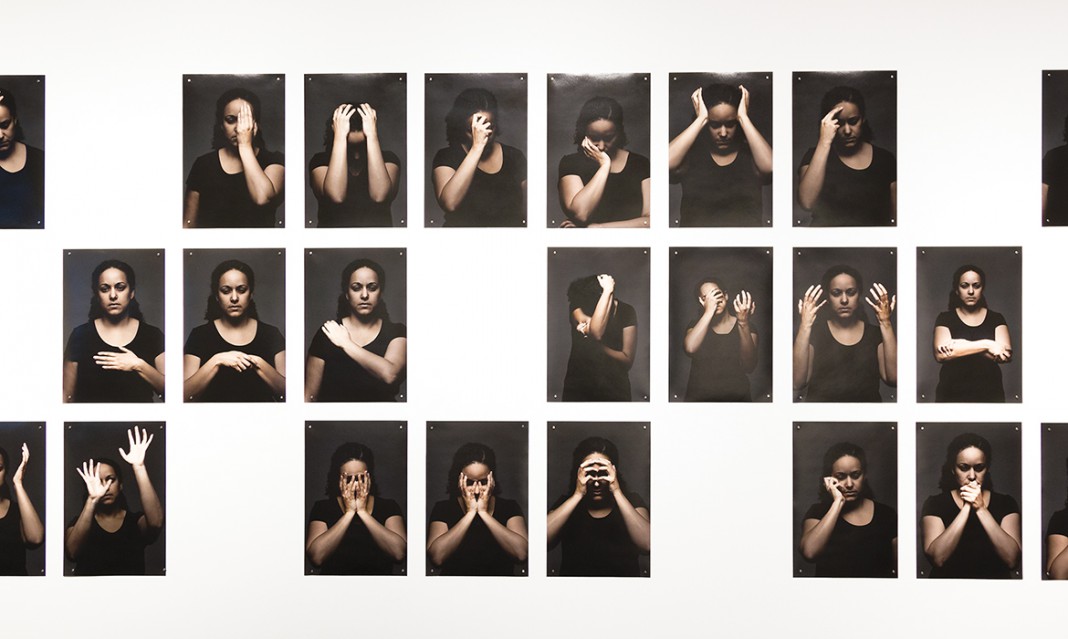I am the kind of person whose emotions are based on what I see others doing. Unfunny movies become funny when I hear a few people laughing and a funeral is only made worse when I see people crying.
For artists like Erika Defreitas, studying how people mourn and being immersed in dozens of obituaries from The Toronto Star leads to powerful art. Her recent exhibition, The Work of Mourning, focuses on exactly that.
I went on a Friday morning. On entering, I was greeted by an introduction on the wall with two quotes: “To weep is to make less the depth of grief” by William Shakespeare, from Henry IV, and “and every tear is from the other, the friend, the living, as long as we ourselves are living, reminding us, holding life, to hold on to it” by Jacques Derrida, from The Work of Mourning.
I was immediately drawn to the 64 photos plastered on one of the walls. In this installation Defreitas depicts the various aspects of grief through many different poses. I felt that some were more powerful than others; the most evocative were the ones where she’s covering her face and hiding it behind her hands and the ones where she’s staring off into the distance with a hand over her heart. Some were stunning and they all told a story.
Defreitas described this part of the exhibit, “A Visual Vocabulary for Hands in Mourning”, as having stemmed from an interest in body language and gesture with public mourning. “When the North Korean leader Kim Jong Il passed away, I was really inspired by the images that I saw of the people mourning his death,” she says. “I started to collect images that I found online or in newspapers of people mourning and started to then re-enact their hands as a way of highlighting how one’s body reacts to grief or through grief. The 64 images on display are from 64 different individual acts of mourning.”
Towards the back of the room there was a piece called “So Buried in It that We Only See Them when Pulled out in Abstractions”, which consisted of abstract, embroidered bodies inspired from actual crime scene photos. Defreitas says her interest in this began a few years ago when she read the newspaper and saw the image of a young person who had been killed in Scarborough. “After seeing this image I became curious about the other images of crime scene photos of bodies under blankets. I started to embroider these images as closely to the original image as possible, but ensuring that the body was covered,” she says. “It was a process of meditation, a process for me to think about the person underneath the blanket and those that are left to mourn them.”
Another exhibit was several glass cases with tissues inside. At first glance I had no idea what I was looking at. White thread ran through some of the tissues and more lay off to the side. But this work, “and every tear is from the other”, is also a personal act of grieving. “Each individual Kleenex is my response to maybe some of the work that I’ve created or personal moments of sadness,” she says. “As I cried, I kept the Kleenex and embroidered with white thread around a single teardrop.” On the plaque to the side was a quote by Derrida: “While tears are a manifestation of the grief brought on by the death of a loved one, they are also an affirmation of life. If we can still weep, we are not dead, and must live on to honour those we have lost.”
The final part of the exhibition was one of my favourites. “In lieu of” consisted of what must have been hundreds of obituaries stacked on top of one another and glossed over with beeswax. Before I knew what was laminating them I thought they looked soaked and withered. They appeared as though people had been holding onto them, wearing them out, and sobbing all over them. It resonated with me.
Defreitas explains that the cutouts are from an earlier work of hers, “Death, Memorials, and Births”, created in 2007. “I had kept these cutouts after reading each and every entry. They were kept in a little black box that I had in my studio. Seven years later I decided to use beeswax because of its connection with Greek and Egyptian mythology and how bees bridge our world and the underworld,” she says. “Wax for me was a way also to increase the preservation of these very delicate newspaper strips.”
The Work of Mourning will remain at the AGM until April.



